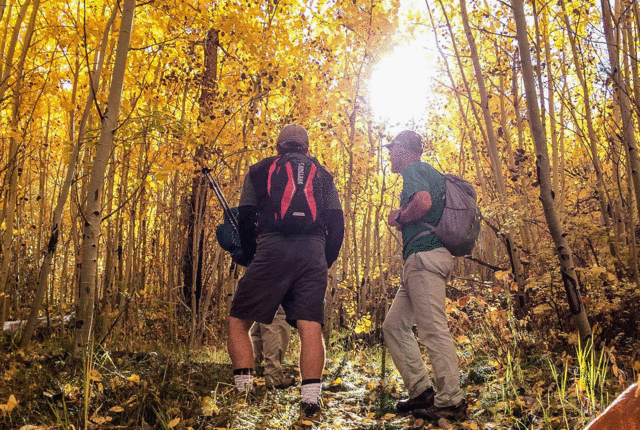THE TRAIL DISAPPEARED INTO THE OLD BURN SCAR. Young aspen and oak, regrown since the 1996 Lama fire, shimmered in yellows, reds, and oranges. We pushed into the growth and scrambled up the ridge, weaving our way through the young forest toward the craggy, windswept knob known as Flag Mountain, which juts 11,946 feet into the blue New Mexico sky.
I was a bit distracted. A downy woodpecker caught my attention. Then a pygmy nuthatch, scooting its way down the bark of an ashen ponderosa pine. I scanned the sky for more birds before realizing I was alone. My companions on this trek, up one of the more prominent peaks of the Columbine-Hondo Wilderness, just north of Taos, had moved on. I hustled along the trail to catch up, stalled here and there by another woodpecker, a young elk, a turkey, then a red-tailed hawk circling above, then a… hey, if I didn’t get a move on, I would never catch up!
The 10.7-mile Lobo Peak Trail led back down into a small valley cut by a singing stream thick with flowers. My crew waited there. Scarlet paintbrush, monkshood, penstemons, and delicate white violets crowded moss-covered boulders and foot-high waterfalls out of a fairy tale. The fire had somehow avoided this little pocket while razing the hillsides above.
We tend to think of forest fires as pure destruction, but fire is an integral part of the American Southwest ecosystem, clearing the forest of debris, fertilizing the soil, germinating seeds, and stimulating growth. After several decades, the burned-over areas burst with life—particularly birdlife.
The largest roadless area in the Southern Rockies, the Columbine-Hondo hosts a bounty of wildlife, from the endangered pine marten to the more common mountain lion, bear, elk, deer, bighorn sheep, and bobcat, and even, some say, the occasional young male wolf, down from Colorado scouting for mates.
In the winter, snow several feet deep blankets the wilderness. Summer sees bright greens and deep evergreen forests. Autumn, however, just can’t be beat. The vast stands of aspen dressing the hillsides light up in sheets of lemony yellows, while golden grasses studded with purple aster cover the high-altitude meadows. There are many reasons to attempt Flag’s summit, but the best one might be the view. Even from well below the peak, the vast New Mexico–Colorado borderlands stretched out before me for dozens, if not a hundred, miles in all directions. When I caught up with my crew, we mounted the valley, tracing the stream’s bank until the trail shot uphill, out of the burn scar and into a series of steep switchbacks. The temperature dropped. The pine, spruce, and fir forest shaded out the sky, and I shivered. We stopped for water and snacks in a stand of towering, ancient aspen carved with the names of locals, some dating to the 1920s and ’30s.
"After several decades, the burned-over areas burst with life—particularly birdlife."
Higher up, the forest opened. The ridge to Flag Mountain is exposed, dominated by Precambrian rock outcrops, grasses, and stumpy pines, bent and twisted into troll-like shapes one might find in the Grimms’ fairy tales. Below and to the west lay the sprawling Río Grande del Norte National Monument. North, the Culebra Range of the Southern Rockies. To the south, Taos Mountain and the Pecos Wilderness stretched all the way to Santa Fe. Gold Mountain and the rest of the 45,000-acre Columbine-Hondo Wilderness spread east, reaching to the highest point in New Mexico, Wheeler Peak.
I was drenched in sweat by the time I topped Flag, and the wind cut to the bone. I always carry a dry change of clothes for just such an occasion. Once changed and warm, we found a little rock shelter. I lit my camp stove and boiled a cup of coffee for each of us. Luxurious, I know. But why not? I nestled into a cranny out of the blow and sipped my coffee while crows and ravens played on the wind.
Read more: The writer, poet, and healer finds inspiration in the mountains of northern New Mexico.
Lobo Peak Trail
nmmag.us/lobopeak

GEAR PICK
Marmot PreCip Rain Jacket
Hiking expert Cindy Brown always has a rain jacket in her pack. On New Mexico’s high-altitude trails, the dangers of hypothermia can occur even in the summer. She recommends the Marmot PreCip Rain Jacket ($100). “During the monsoon season in July, you’ll need something sturdy and waterproof,” she says. “So many times, the hat and gloves I had in my pack came in handy when a rain or hailstorm moved in unexpectedly.”



